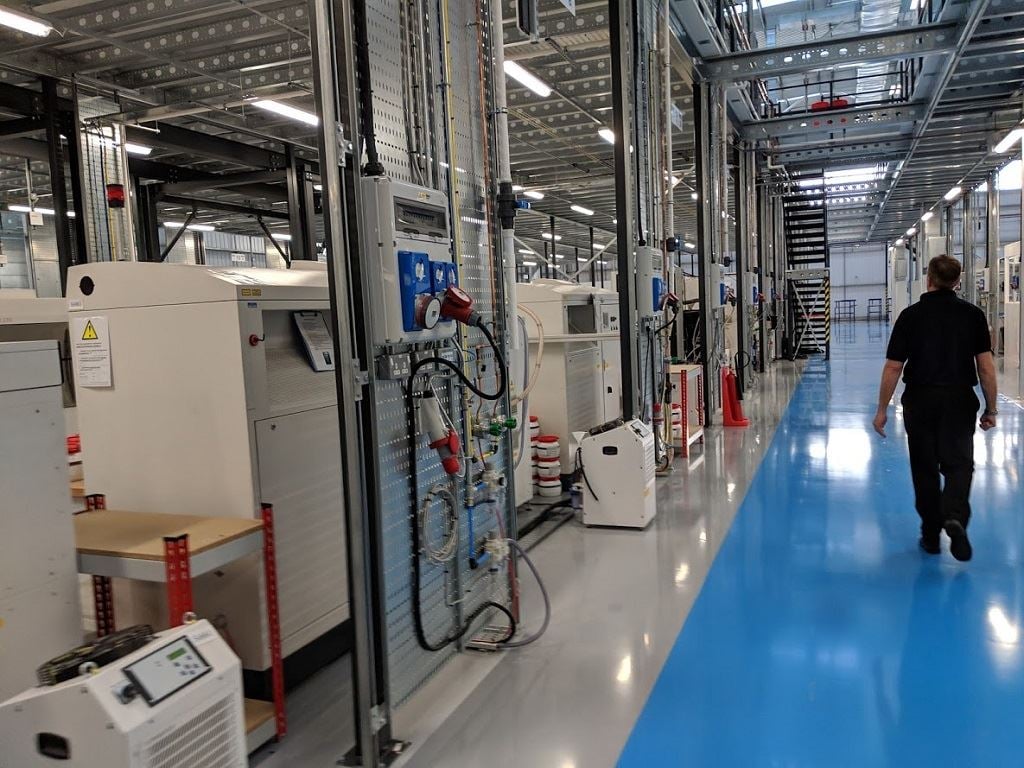![Phil Hatherley, General Manager, Materials Solutions, leads the way through the 3D printing floor at the Materials Solutions facility in the UK [Image: Sarah Goehrke/Fabbaloo]](https://fabbaloo.com/wp-content/uploads/2020/05/siemens2a_img_5eb09348a4439.jpg)
Siemens is stepping up its leadership in the industrialization of additive manufacturing with its latest big IDEA.
IDEA — or Industrial implementation of Digital Engineering and Additive manufacturing — is a three-year project, funded by grants totaling almost €14 million.
The German Ministry of Education and Research project aims “to reduce development and production times in the powder-based additive manufacturing of complex metal components by approximately 50 percent.”
A Big IDEA
![Materials Solutions’ UK facility highlights an important leadership message for Siemens [Image: Sarah Goehrke/Fabbaloo]](https://fabbaloo.com/wp-content/uploads/2020/05/siemens1a_img_5eb093491c74b.jpg)
The project, as many wide-reaching, well-funded, and ambitious projects are, is a collaborative effort.
This one brings together 14 partner entities from business and research to work together under the IDEA umbrella as they turn full attention to industrializing and automating additive manufacturing.
In full, the partners include:
-
ALLMATIC
-
BCT
-
Jenoptik
-
ModuleWorks
-
Siemens Digital Industries
-
EOS
-
TRUMPF
-
Liebherr-Aerospace
-
MBFZ toolcraft
-
MTU Aero Engines
-
Siemens Gas and Power
-
Fraunhofer Institute for Laser Technology (ILT)
-
Fraunhofer Institute for Production Technology (IPT)
-
RWTH Aachen University, including its Machine Tool Lab (WZL) and School of Digital Additive Production (DAP)
The partners represent a wide spectrum of hardware companies, software suppliers, industrial 3D printing companies, 3D printing users, and research institutions — all coming together with this one overarching goal.
And at the head of the consortium classroom, as it were, is Siemens.
“Within IDEA, Siemens is taking a clear leadership role in helping to shape the industrialization of additive manufacturing,” remarks Markus Seibold, head of Additive Manufacturing at Siemens Gas and Power. “In an interdisciplinary industrial partnership, we can work faster and more efficiently than any company can do in isolation.”
Production Focus
As we often see, additive manufacturing is working toward wider adoption in industry — and this is rarely a straight line of progress.
For 3D printing to truly take its place among traditional manufacturing processes, the technology must prove itself thoroughly in every aspect to provide results at least equal to those already available. If not, why would any manufacturer switch over to a new technology?
We often hear about additive manufacturing working together with other processes to provide better results in terms of speed, quality, costs, and final part quality — and each of these aspects requires significant R&D before coming together as a working overall solution.
For IDEA, the priority is in industrial applications. Work ahead requires “more efficiently linking hardware and software,” including more frequent and more efficient use of digital twins in order to create a more streamlined workflow for more efficient production lines.
The second half of the project will validate that work, measuring achievements as demonstrated in two pilot lines. These prototype industrial production lines will be built in the Siemens gas turbine factory in Berlin and at MBFZ toolcraft in Georgensgmünd.
Goals
Going back to one of the original points raised, it’s worth revisiting: the project aims “to reduce development and production times in the powder-based additive manufacturing of complex metal components by approximately 50 percent.”
Siemens and the IDEA partners are collectively well aware of the many steps involved in additive manufacturing — encompassing in brief the concept, design, 3D printing, iterating, quality control, heat treatment, post-processing. With the overarching goal specifically targeting improvements in metal additive manufacturing, these stages also include metallurgical and safety considerations such as flammability, powder handling, and even removal of parts from the build plate.
Essentially: there’s a lot to metal additive manufacturing.
And the heart of this IDEA is to cut the complexity in half.
So this is a pretty big IDEA, indeed.
Via Siemens











